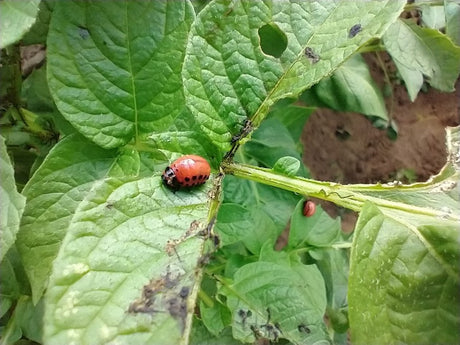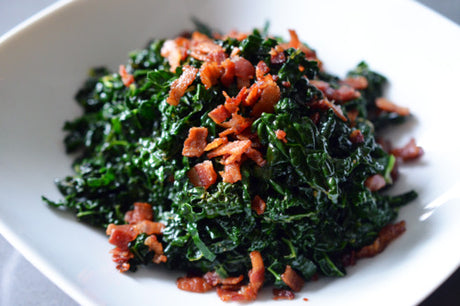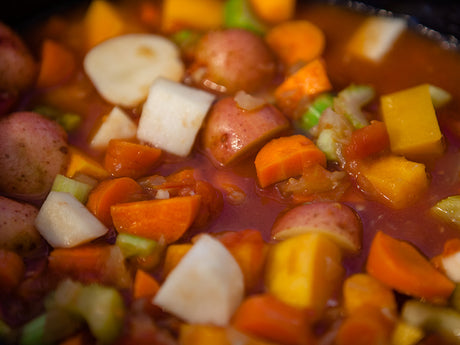Sowing broad beans: tasty and easy-to-grow vegetable
Introduction to sowing broad beans
Sowing broad beans is truly fantastic for your smaller vegetable garden. You get so much value for your space—the plants yield a bountiful harvest without taking over your entire garden. The best part, of course, is picking them fresh from the plant and eating them immediately, or tossing them in the freezer right after harvesting. Trust me, the flavor of your own broad beans is so much better than anything you can buy in the store. Not familiar with them yet? Then you really need to try them. They truly are the earliest vegetables you'll have on your plate this year. Did you know that broad beans are winter-hardy and can be sown as early as October and November for an early spring harvest?
Broad bean seeds are very inexpensive, and their large size makes them incredibly easy to work with. They germinate very easily, but they do dislike overwatering—something to keep in mind. If your vegetable garden has clay soil, you'll need to be extra careful. Don't sow them if the weather forecast only predicts raindrops, as your seeds will rot and become a tasty snack for worms. Broad beans are also called lab beans and, thanks to their ease of growing, are perfect for beginners. We always recommend the Witkiem variety—it thrives in our climate. Furthermore, broad beans don't require additional nitrogen fertilizer because they can fix nitrogen.
Preparing the soil and seeds
Want to grow broad beans in your vegetable garden? Then you'll naturally start by properly preparing the soil. Broad beans are actually quite easy to grow; they prefer airy, humus-rich soil with a pH between 6.0 and 7.0. Mixing some compost into your soil will give those little seeds a real jump-start and lay the foundation for a bountiful harvest you can be proud of. Just make sure your soil isn't too wet when you sow, as too much moisture will cause your seeds to rot before they even have a chance to germinate. What a waste of all that beautiful seed! Protect the seeds from birds and mice with netting to prevent them from being eaten.
It's best to store your broad bean seeds dry and clean until you're ready to plant them. Want to speed up germination a bit? Simply soak them overnight in water before sowing. Don't make it difficult, just do it! If you're sowing your broad beans in the ground, plant them about 5 cm deep and leave about 20 cm between the seeds. This way, your plants will have plenty of room to grow, and you'll soon be able to enjoy your own fresh broad beans. This simple preparation lays the foundation for strong plants and a delicious harvest you can enjoy all summer long. Broad beans germinate at 5 degrees Celsius, making them ideal for early cultivation.
How to sow broad beans from seed
When do you take action?
Broad beans are winter-hardy, meaning you can simply sow them in October and November. Within two to four weeks, the seeds will germinate, resulting in small plants that will happily overwinter. With the first warm spell, they'll continue growing happily until harvest in May. However, you can also sow broad beans as early as late January or mid-February, depending on the weather. I sow my broad beans between February and April—depending, of course, on the weather and the condition of my soil. I have well-draining sandy soil, and if February doesn't experience too much frost, I sow as soon as possible. For an extra early start, you can sow broad beans in a cold frame in early spring. This provides protection from the cold and birds, and ensures that the young plants are strong enough to be transplanted into the ground later. When sowing, you can easily place a small plastic tunnel over the rows. This warms the soil nicely and aids germination. Sowing broad beans under glass can be done as early as January and February. Expecting a hard frost of -5°C or lower? Consider using fleece to protect your broad beans at night. They can tolerate a light frost. The reason we sow so early is actually to avoid black aphids—the later you sow, the more trouble you'll have with those pesky critters.
Direct sowing
Most gardeners simply sow their broad beans directly into the ground – this is also called open-field sowing. Some use a plastic tunnel, while others sow directly without protection. In March and April, you can usually work without a tunnel. When sowing, always choose a sheltered and sunny spot: broad beans grow best in a location with plenty of sunlight and sheltered from strong winds. A sheltered spot or natural windbreaks, such as a row of peas along a trellis, will help block strong winds and prevent damage to the plants. Don't sow your broad beans in very wet soil, as excessively wet conditions can cause the seeds to rot. Use rich, compost-rich soil – they love it. But don't use fresh manure, as it will burn your seeds (and we certainly don't want that).
Sow your broad beans in double rows 23cm apart, leaving 23cm between each plant. Sow the two rows in a checkerboard pattern – this gives them more room to spread. If you want to sow another double row of broad beans, leave 60cm between the rows (see the image). Sow your broad beans 5cm deep – they're about the size of a euro coin, so you need to plant them fairly deep. Germination takes between two and four weeks, depending on the temperature.
Sowing broad beans in your greenhouse or greenhouse
You can also choose to sow your broad beans in a greenhouse , conservatory, or cold frame. Sowing is easy in trays, pots, or a cold frame. I simply use 51-hole trays or P7 pots for this—they work perfectly. Universal potting soil is suitable for growing seedlings; you don't need special seed starter mix. Germination will be a bit faster, but if you leave the seedlings in the pots too long, the roots will start to suffocate each other. So plant them out in time! You can sow broad beans under glass as early as January and February. Transplanting seedlings, or planting out the broad beans, should be done as soon as the plants are sturdy enough and there's little chance of frost. It's best to plant broad beans when the soil has warmed up and is easily workable; ensure sufficient fertilizer and plant them in a sunny, sheltered spot. Are you having trouble with mice or snails in your vegetable garden? Then pre-sowing is a really smart choice. If you're starting indoors, be sure to use grow lights – on a windowsill, you'll get slender, fragile plants that will stretch. Even if the soil is soaked or frozen, it's better to pre-sow under glass or indoors under grow lights. I never put my broad beans under grow lights indoors – they simply go in my greenhouse. I save my grow lights for plants that can't go in the greenhouse before April, such as peppers, bell peppers, and eggplant. Once the soil has warmed up and dried out a bit and the root system is already well-developed, I plant them out in the open ground. Of course, this also applies to full sun and well-protected from the wind. Don't forget to harden off your plants before planting them out – put them outside for a few hours each day so they can acclimate to the weather and wind. Tip: Sowing peas with broad beans provides natural wind protection and extra support for the plants.
Some more tips for growing broad beans in the open ground
A little support in windy vegetable gardens
Is your vegetable garden exposed to a lot of wind? Then place a stake, trellis, or cane at each corner of your double row. For extra stability, you can place a row of bamboo canes and stretch a wire between them. Also, tie rope between the canes, trellis, or stakes. This will provide your plants with some support, prevent them from being blown over, and keep them stable thanks to the wire along the row of bamboo canes. For taller varieties, it's necessary to support them with stakes and rope, as otherwise they might topple over due to their height and weight.
Keep it nice and moist, will you?
Unlike your bush and princess beans, you need to keep your broad beans well-moistened. Especially when the first flowers appear – that's when they really need some extra water. Give the plants a generous watering during flowering and two weeks later. This helps the plants develop healthy pods and prevents dehydration during this crucial growth phase.
Rake between the rows regularly
Pinch off the tops of the plant when you see the first flowers. This discourages black aphids and also helps prevent aphids. This encourages the plant to produce even more flowers – a win-win situation.
Growing broad beans in pots or containers
You can easily grow broad beans in pots or containers if you're gardening on a patio or balcony. You can plant two seeds in a 2- to 3-liter pot with a circumference of about 18 cm. Broad beans have a deep root system, so choose a pot or container at least 20 cm deep. For best results, use all-purpose potting soil as a substrate. Keep the soil moist throughout the entire growing cycle.
Harvesting broad beans in your own garden
Harvest your broad beans when they are a good 20cm long and the pods are nicely full. You can feel this by gently pressing the pod. You can harvest beans as soon as the pods feel firm, but be careful: as the broad beans get larger (usually with pods of 12-15cm), the flavor may diminish. Beans, or young pods, are often more tender and versatile in the kitchen. You should harvest broad beans when the pods are well filled but not too hard. You can eat the pods while they are still small; young pods and even the flowers of the broad bean plant are edible and delicious in salads. Harvest pods when they are still flat and the seeds are barely visible, and pick edible flowers during flowering for added flavor. Broad beans are usually ready to harvest 90 to 100 days after sowing.
I usually harvest in two or even three batches—any pods with loose broad beans inside I leave hanging until my next visit. Helpful tip: the sprout on the side of the broad bean should be white. If it's black, the broad bean is too far along and will become tough. After harvesting, you can store the broad beans in the refrigerator for up to three days. Broad beans are ideal for freezing. Simply twist the pods, remove the beans, and freeze them. The beans have a skin—I like to remove it before eating them, but I leave it on when freezing.
Preparing and storing broad beans
Broad beans are such a rewarding vegetable in your kitchen. You can really do anything with them: cook them deliciously, simmer them gently, roast them until they're a bit crispy, or simply toss them raw into a fresh salad. And what's handy: in many recipes, you can use broad beans as a great substitute for peas, or even add both for added color and flavor. I often do that myself—it adds such a pleasant, full flavor to your dish.
Want to store your broad beans for a while? You're in luck, because it's perfectly possible. It's best to freeze them immediately after harvesting or refrigerate them—this way they stay nice and fresh and preserve all those good nutrients. Before freezing, remove the beans from their pods and briefly blanch them (don't bother, just briefly boil them). You can keep broad beans in the refrigerator for a few days, but use them as soon as possible—fresh broad beans are simply the tastiest. You can also dry them or pickle them in vinegar or oil, so you can enjoy your harvest all year round. And to top it all off, broad beans are packed with fiber, protein, vitamins, and minerals—a real asset to your daily meals.
Diseases and threats
Mice
Mice love broad beans, especially late and early in the year when food is scarce. They dig up the seeds before they have a chance to germinate – annoying! As mentioned before, if you have a problem with voles or other rodents, sow them in the greenhouse or conservatory. You can set traps to address the problem, or cover your broad beans with fleece to outsmart the mice.
Black aphid or black bean aphid
Black aphids can make your life quite miserable. Black aphids are a type of aphid that's common in vegetable gardens. You'll find them on the growing tips of plants, where they suck the sap from the young leaves and also attack your beans. When the first flowers appear, you can pinch out the buds and spray them with an organic product; natural pest control methods like a mild soap solution can also help get rid of aphids.
Chocolate stain
This phenomenon is often seen during a wet spring. You can recognize the disease by dark red, chocolate-brown spots on the leaves and stems of the plants. This disease can jeopardize your entire harvest. Remove affected plants and discard them from the vegetable garden.
So, now you know a whole lot more about sowing broad beans! Did you find this article helpful? Then consider purchasing your gardening supplies from Plukkers.com in our online store. This way, you'll help us write many more valuable articles.
Conclusion
Growing broad beans is such a fun activity for your vegetable garden – and it's much easier than you think! With a little attention to your soil and seeds, and of course, the right care, you can count on a fantastic harvest. And then the best part: cooking, stewing, roasting, or pickling – broad beans really go with everything and are packed with healthy nutrients. By growing them yourself, you simply have your own fresh produce in the garden, hassle-free. Just be sure to watch out for that pesky black bean aphid (you've probably heard of it!), but with a little vigilance, you can easily keep them at bay. With a little knowledge and, above all, a passion for gardening, you can thoroughly enjoy your own fresh broad beans – from your own soil straight to your plate, it doesn't get any better than this!










